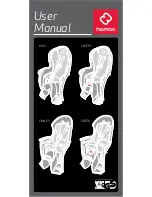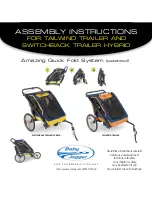
Components of the bicycle
8
The factory set brakes have to be checked before the first ride.
To do this, please pull hard on both brake levers in standing and try to push the bicycle. The wheels
should not turn. You should also not be able to pull the brake lever all the way to the handlebars.
If the brakes are not working properly, you are not allowed to ride the bicycle! Otherwise you run a
great risk of falling and sustaining serious injury! Brake pads and cables are subject to wear and
therefore have to be serviced and replaced.
Rim brakes and rims subject wear on each other. Fine cracks can also occur on
rims, or rim flanges can become misshapen when air pressure is increased. You
can reduce this wear by riding conscientiously, not braking too hard or for long
sustained periods.
The brake pads have to be regularly checked or replaced. This also applies to
the rims, if your bicycle has rim brakes.
Legislation stipulates that rims have to have wear indicators in the form of a
groove or easily visible dots. If these indicators can no longer be seen in just
one area, then you should immediately have the rim changed by your specialist
retailer!
If you are using your bicycle off-road, this also increases the stress for frames and components. As
a result, you should check the technical condition of your bicycle more thoroughly and regularly.
Disc brakes
If your bicycle is fitted with disc brakes, congratulations – you have purchased the most up-to-date
and best type of brakes available for bicycles.
Please note that a disc brake system may be far more powerful than you are used to!
Please practice using your new disc brakes before your first ride and before using the bicycle on
public roads. Disc brakes are also more effective in wet conditions than all types of rim brakes.
To get the most out of your brakes, please note the following:
You can adjust the gap between the brake lever and the handlebars to suit the size of your hands.
•
Braking is safer if the brake levers have been adjusted to the right size for you.
New brake pads have to brake hard 10 to 20 times from a speed of 30 km/h before they reach
•
their full potential. It is recommended you do this, but with extreme care. Look for a quiet location
without traffic and ensure that you always keep your bicycle under control.
If you are transporting your bicycle with the wheels removed, do not pull on the brake levers. This
•
can lead to unwanted air in the system or that the brake pads are pressed too far together. Install
a barrier between the brake pads if you remove the wheels.
Please check the brakes and brake lines regularly for escaping brake fluid. If you notice that brake
fluid is escaping somewhere, please refrain from using the bicycle and take it to your specialist
retailer for checking. Hydraulic brakes with an open or leaky system are unable to build up sufficient
brake pressure and are therefore unable to brake safely!
Please check the thickness of the brake pads before every ride. Pads less than 0.5 mm thick have
to be replaced before starting the ride.
Never touch the brake disc of a rotating wheel. You can suffer serious injuries if your finger is caught
in the rotating disc!
Brake disks and callipers can get hot under braking. Never touch the brake disk or calliper after you
have braked. You are in danger of suffering burns.
Never touch the brake disk with your hand, as it must remain free of all lubrication. This is the only
way for you to brake safely.
Bent brake lines should also be checked by a specialist immediately.
Avoid contact with the brake fluid! It is corrosive and poisonous and is capable of damaging your
health and property!
There are many different models of disc brakes, with their operation, maintenance and setup greatly
varying. Please make sure to inform yourself by reading the enclosed instruction manual. Detailed
information is also provided on the manufacturer’s websites:
http://www.magura.com/de/produkte/scheibenbremsen-2010/prod/louise-30/info/downloads.html,
http://www.sram.com/en/XX/products/brakes.php
Headset
The headset is the bearing for the fork in the frame. Road shocks place a large
amount of pressure on this component, moving it or loosening it. However, it is
important that it turns easily and is not at all loose. You can check this yourself
by wrapping your fingers around the lower bearing shell, pulling the front brake
with your other hand and pushing the bicycle back and forward. If you can feel
the bearing moving then it has to be adjusted. To check how easily the bearing
moves, you have to lift the front wheel up with the frame and you should be
able to easily turn the fork of the front wheel to both sides with just two fingers.
The same applies here: Required modifications should be carried out by
specialists as special tools and experience are required to do this. If you want
to carry out the work yourself, please pay close attention to the information
provided by the manufacturer. Improperly setup headsets can lead to breaks and falls.
Frame
Various materials, such as aluminum or carbon, are used to build frames. Carbon is a very special
material which doesn’t always clearly show signs of damage sustained during use when the bicycle
falls over or you crash. Some deformations, fractures and fibrous cracks can only be identified
through closer inspection. As a result, the torque for bolts in/on carbon frames
and components is sometimes substantially lower than is the case with other
materials. Children’s seats are not allowed to be fitted to carbon frames. Miss
-
hapen carbon components have to be replaced. Precise and regular checks
by a specialist are essential for bicycles built out of this modern material!
A properly set up
frame
ensures that your bicycle will ride in a straight line.
Your specialist retailer is able to test the bicycle’s track. Both stipulate how the
bicycle behaves during riding and how comfortable it is to ride. Every frame has
a frame number. This is either located on the rack fixture, on the seat tube or the bottom bracket
shell.
It is vital to check the frame thoroughly after a fall; bent or broken parts can cause serious injuries!
These may not be repaired but have to be replaced, otherwise there is an increased risk that they
might break.
Fork
The front wheel and brake are attached to the fork.
The fork consists of the fork blades, fork bridge and steerer. Damaged or bent
forks should always be replaced otherwise there is an increased possibility of
serious accidents! In order to increase riding comfort, many bicycles are equip-
ped with a suspension fork. To set up the various different models (Air/oil forks,
elastomer fork, steel spring fork), please refer to the information provided by the
manufacturer or contact your specialist retailer.
The websites of the respective suspension manufacturers are also a great
Rim with wear
indicator
Headset
Carbon frame
Carbon fork (left),
Suspension fork (right)
Содержание DHM
Страница 1: ......
Страница 19: ...Technology 19 Operation of front derailleur levers FD 6700 ...
Страница 20: ...Technology 20 Installation of the brake cable ...
Страница 21: ...Technology 21 ...
Страница 26: ...Technology 26 SIS Adjustment ...
Страница 29: ...Technology 29 Installation of the hub to the frame ...
Страница 30: ...Technology 30 General Safety Information Narrow type chain ...
Страница 37: ......
Страница 38: ...HM Bike Consulting GmbH ch des Prés 21 CH 1279 Chavannes de Bogis www hmbike com ...









































